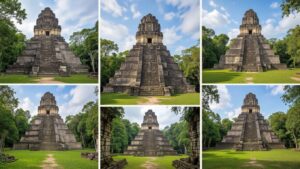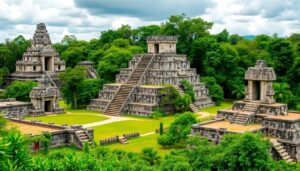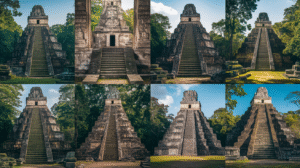Belize is globally acclaimed for housing the highest density of ancient Maya sites in Central America, with over 1,400 documented locations that span an impressive timeline exceeding three millennia. From the awe-inspiring riverbank temples at Lamanai to the monumental pyramids of Caracol, each archaeological site offers profound insights into the complex facets of Maya governance, spirituality, and the daily existence of the Maya populace. This comprehensive guide will explore nine pivotal ruins that deserve a visit, provide practical travel planning advice, and furnish the necessary cultural context for a deeply immersive experience of Belize’s archaeological wonders.
Uncover the Reasons Behind Belize's Status as the Heart of Ancient Maya Civilisation
The rise of the Maya civilisation in present-day Belize can be traced back to at least 2000 BCE and thrived robustly until well into the Spanish colonial era. The prosperity of this civilization was significantly bolstered by the fertile river valleys, especially along the New River and Belize River, coupled with coastal access to the rich marine resources offered by the world's second-largest barrier reef. Furthermore, a complex network of trade and political alliances underpinned their economic vitality. Currently, the Institute of Archaeology, a component of the National Institute of Culture and History (NICH), is responsible for the stewardship of 14 designated archaeological reserves, many of which are situated within or adjacent to UNESCO World Heritage sites. Their ongoing initiatives, combined with decades of scholarly research, elucidate how the communities of the Belizean Maya have profoundly influenced the broader historical narrative of the region.
Discover the 9 Must-See Maya Ruins for an Authentic Belize Experience
Investigate the Maritime Trading Centres of Northern Belize
Lamanai: “Submerged Crocodile” – The Longest Inhabited Maya Settlement
Lamanai, derived from the Yucatec Maya phrase Lama’anayin, translating to “submerged crocodile,” is strategically positioned along the banks of the New River Lagoon and boasts a remarkable history of habitation from the 16th century BCE to the mid-20th century CE. This site was pivotal as a trading nexus, forging essential links between inland communities and coastal traders. Visitors typically approach by boat from Tower Hill, where they can explore the magnificent Mask Temple, featuring a striking 2.7-meter stucco mask that embodies the rain deity. Furthermore, the Jaguar Temple and the towering High Temple rise majestically above the verdant jungle canopies. Ongoing archaeological investigations by NICH have unearthed residential courtyards, a ballcourt, and substantial evidence of trade involving jade, obsidian, and ceramics (Institute of Archaeology, NICH).
Altun Ha: “Rockstone Water” – The Historic Site of the Jade Head Discovery
Located approximately 50 kilometres north of Belize City, Altun Ha, which translates to “rock water,” gained international acclaim in 1968 when excavators from the Royal Ontario Museum uncovered the extraordinary 4.42 kg jade head of Kinich Ahau. This artefact is the largest carved jade object discovered from the Maya civilisation and is presently exhibited at the Museum of Belize (Royal Ontario Museum). The site is home to the 16-metre-tall Temple of the Masonry Altars, which offers a commanding view over ancient trade routes that historically linked inland polities to Caribbean ports. Interestingly, unlike many other Classic-period centres, Altun Ha lacks inscribed stelae, indicating that its elite preferred grandiose sculptures to hieroglyphic inscriptions (Pendergast 1979).

Santa Rita: A Crucial Site of Late-Period Cultural Exchange
Positioned near Corozal Town, the Santa Rita site remained an active settlement well into the early colonial period. The artefacts discovered here, including pottery and objects from the Spanish era, document how the Maya adapted to European influences and interactions. Moreover, the adjacent Cerros site, interconnected by a network of causeways, highlights the economic resilience and evolving trading systems of northern Belize during the late period (Awe 2005).
Investigate the Political Strongholds of Western Belize (Cayo District)
Xunantunich: The “Stone Lady” Legend and the Majestic El Castillo Pyramid
Perched on a prominent bluff overlooking the Mopan River, Xunantunich, meaning “Stone Lady” in the Mopan Maya language, features the iconic El Castillo pyramid, which soars to an impressive height of 43 metres. Visitors must first cross the river using a hand-cranked ferry before ascending through the jungle to reach the site. Once there, they can admire an astronomical frieze that illustrates the cycles of the sun god and Venus. Local lore speaks of a ghostly figure, often described as a white-robed spirit, seen atop the central plaza, adding an element of mystery to the site (Chase & Chase 2015).
Caracol: The “Snail” – The Largest Maya Site in Belize
Covering over 200 square kilometres, Caracol reached its zenith around 650 CE, boasting an extensive population of approximately 120,000 inhabitants, which positioned it as a formidable rival to Tikal in terms of power and prominence. The site’s Caana (“Sky Place”) temple ascends to a remarkable height of 43 metres, making it the tallest man-made structure in Belize. Throughout the site, more than 120 carved stelae document dynastic victories, including the notable conquest of Caracol over Tikal in 562 CE, while inscriptions provide crucial insights into the political history of the Maya civilisation (Chase & Chase 1996). Furthermore, advanced agricultural methodologies and hydraulic systems reflect the sophisticated urban planning that characterised Caracol.
Cahal Pech: “Place of Ticks” – A Royal Acropolis Complex
Cahal Pech, translating to “place of ticks” in Yucatec Maya, is located atop a ridge that overlooks San Ignacio. As one of the earliest civic-ceremonial centres in Belize, dating back to around 1200 BCE, the site showcases limestone palaces and ballcourts that exemplify early Maya architectural styles. Its advantageous location near the town makes it an ideal destination for families and visitors who seek a gentle introduction to the rich history of Maya ruins (Powis et al. 2010).
Explore the Unique Architectural Styles of Southern Belize’s Maya
Lubaantun: “Place of Fallen Stones” – Notable for Its Mortarless Construction
Nestled within the misty hills of the Toledo District, Lubaantun is characterised by its distinctive black slate masonry, constructed without mortar using ingenious “in-and-out” techniques, resulting in a striking stepped appearance. The site features three ballcourts and numerous burial caches that suggest its significant ritual importance. Additionally, it is here that the infamous crystal skull reportedly surfaced in 1924, although scholars continue to debate its authenticity and origins (Mitchell-Hedges 1998).
Nim Li Punit: “Big Hat” – The Home of the Tallest Stela in Belize
Also situated in the Toledo region, Nim Li Punit features 26 intricately carved stelae, the most notable being Belize’s tallest monument, which depicts a king adorned with a towering “big hat.” The stelae plaza is believed to have functioned as an astronomical observatory, marking significant equinox alignments, thereby showcasing the Maya's advanced understanding of astronomy (Helmke & Awe 2016).

Uxbenka: Recent Discoveries Highlight Astronomical Alignments
Since 2015, archaeological excavations at Uxbenka have uncovered temple platforms that are meticulously aligned with the points of the solstice sunrise, underscoring the remarkable astronomical acumen possessed by the Maya. Positioned near the Guatemalan border, this rural site offers pristine exploration opportunities and provides invaluable insights into the political dynamics of Classic-period southern Maya societies (Smithsonian Mesoamerican Research).
Essential Planning Tips for an Unforgettable Maya Ruins Adventure
Transportation & Access:
Accessing most Maya sites necessitates ground transportation. From Belize City, daily bus services and private shuttles transport visitors to San Ignacio and Corozal; from these points, various tour operators offer 4×4-driven site visits. Notably, reaching Caracol requires a 16 km drive along unpaved roads, which can often become difficult to navigate during heavy rains, particularly from June to October. Domestic flights are available that connect Belize City’s Philip S.W. Goldson Airport to San Pedro and Dangriga, but these flights do not serve inland sites.
Entry Fees & Guided Tours:
All reserves managed by NICH impose official entry fees that range from USD 12 to 25. For further information, visit the Belize Tourism Board. Engaging licensed guides can significantly enhance your visit as they provide expert insights into hieroglyphs, architectural features, and the ecological context of the sites. It is crucial to note that research permits are stringently enforced for academic projects.
Optimal Visiting Times:
The best period to explore the sites is during the dry season from November to April, which typically results in sunny days, manageable humidity levels, and ideal conditions for photography. It is advisable to avoid peak holiday periods, such as Christmas to New Year, when local resorts are usually fully booked. Additionally, the shoulder months of May and October may offer lower rates and moderate rainfall.
Essential Packing List:
Visitors should be well-prepared with sun protection including a wide-brimmed hat and reef-safe sunscreen, along with long-sleeved shirts to protect against insects. Sturdy hiking shoes are vital for traversing the terrain, and it's wise to pack water, electrolyte snacks, and extra camera batteries. A lightweight rain jacket can also prove invaluable in the event of sudden tropical downpours.
Gain Profound Insights into Maya Civilisation Through Their Spectacular Ruins
During the Classic Period (250–900 CE), the Maya civilisation achieved extraordinary advancements, including the refinement of hieroglyphic writing, which remains the longest pre-Columbian script in the Americas. They also conceptualised zero within their vigesimal numbering system. The orientations of temples across Belize reveal intricate ties to solar and Venus-cycle observations, essential for their ritual calendars. Extensive riverine trade networks facilitated the exchange of jade, obsidian, cacao, and salted fish between coastal and highland polities, forging crucial economic interdependencies throughout Mesoamerica (Helmke & Awe 2016).
Highlighting the Importance of Conservation and Respect for Cultural Heritage
The Institute of Archaeology (IA-NICH) in Belize enforces a stringent permit system for both research and tourism activities, overseeing the management of 14 archaeological reserves. To mitigate wear on fragile limestone structures, visitor limits are enforced during peak hours, and entrance fees directly contribute to the preservation efforts of these sites. Local guide programmes ensure that income generated through tourism directly benefits the Maya communities. Furthermore, photography restrictions, such as prohibiting flash in mural-rich chambers and preventing climbing on delicate structures, are implemented to safeguard these invaluable sites for future generations.

Explore the Resilience of Modern Maya Communities and Their Cultural Heritage
Today, the Maya communities residing in Toledo continue to uphold traditional milpa agroforestry systems that involve rotating crops such as corn, beans, and squash, reflecting ancient agricultural practices. Additionally, community-based tourism initiatives along the Toledo Maya Cultural Route provide authentic homestays and traditional culinary experiences, effectively linking heritage preservation with economic empowerment for local populations (Belize Maya Forest Trust).
Comprehensive Bibliography for Further Exploration
-
Institute of Archaeology, NICH. “Protected Archaeological Sites.” https://nichbelize.org
-
Royal Ontario Museum. “Altun Ha Excavations.” https://rom.on.ca
-
Pendergast, David. Altun Ha: Jade Head Discovery and Context. Museum of Belize, 1979.
-
Awe, Jaime. Archaeological Research in Corozal and Santa Rita. Northern Arizona University Press, 2005.
-
Chase, Arlen & Diane. Xunantunich and Caracol: Temple Sites of Western Belize. UNLV Reports, 2015.
-
Chase, Arlen & Diane. Caracol Archaeological Project Reports. UNLV Reports, 1996.
-
Powis, Terry et al. “Cahal Pech Excavations and Regional Role.” Journal of Maya Studies 12, no. 2 (2010).
-
Mitchell-Hedges, Anna. Mysteries of the Crystal Skull. London: Explorer’s Press, 1998.
-
Helmke, Christophe & Jaime Awe. “Ancient Maya Territorial Organisation and Astronomy.” Mesoamerican Research Journal 22, no. 1 (2016).
-
Smithsonian Institution. “Uxbenka Archaeological Project.” Mesoamerican Research, 2021.
-
Belize Maya Forest Trust. “Community-Based Cultural Route.” https://belizemayaforest.org
The Article Ancient Maya Ruins in Belize: Complete Guide to 9 Archaeological Treasures appeared first on Belize Travel Guide
The Article Ancient Maya Ruins: Your Complete Guide to Belize’s Treasures Was Found On https://limitsofstrategy.com

